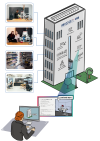Differences
This shows you the differences between two versions of the page.
| Both sides previous revisionPrevious revision | Next revisionBoth sides next revision | ||
| teaching:gsoc2018 [2018/01/22 13:01] – gkazhoya | teaching:gsoc2018 [2018/01/22 13:02] – gkazhoya | ||
|---|---|---|---|
| Line 51: | Line 51: | ||
| - | ===== CRAM - executive and toolbox for creating cognitive robot behavior | + | ===== CRAM - Cognition-enabled Robot Executive |
| CRAM is a software toolbox for the design, implementation and deployment of cognition-enabled plan execution on autonomous robots. CRAM equips autonomous robots with lightweight reasoning mechanisms that can infer control decisions rather than requiring the decisions to be preprogrammed. This way CRAM-programmed autonomous robots are more flexible and general than control programs that lack such cognitive capabilities. CRAM does not require the whole reasoning domain to be stated explicitly in an abstract knowledge base. Rather, it grounds symbolic expressions into the perception and actuation routines and into the essential data structures of the control plans. | CRAM is a software toolbox for the design, implementation and deployment of cognition-enabled plan execution on autonomous robots. CRAM equips autonomous robots with lightweight reasoning mechanisms that can infer control decisions rather than requiring the decisions to be preprogrammed. This way CRAM-programmed autonomous robots are more flexible and general than control programs that lack such cognitive capabilities. CRAM does not require the whole reasoning domain to be stated explicitly in an abstract knowledge base. Rather, it grounds symbolic expressions into the perception and actuation routines and into the essential data structures of the control plans. | ||
Prof. Dr. hc. Michael Beetz PhD
Head of Institute
Contact via
Andrea Cowley
assistant to Prof. Beetz
ai-office@cs.uni-bremen.de
Discover our VRB for innovative and interactive research

Memberships and associations:











